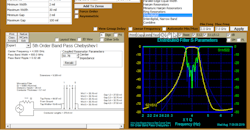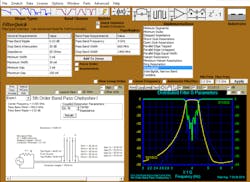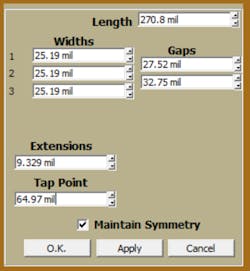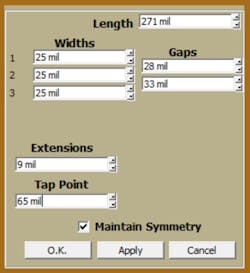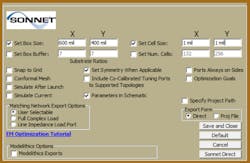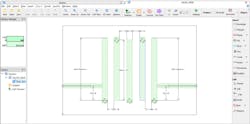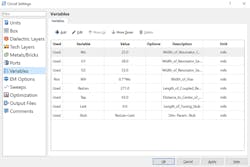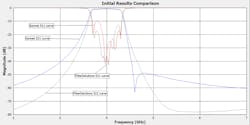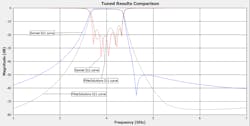Workflow Carves a Path to Effective Filter Design
Download this article in PDF format.
Simulation-based filter design can be tackled in different ways thanks to the various simulation tools available and the functionality within them. Generally, these tools offer a range of features that help build a more streamlined design process for both seasoned designers and novices alike. This article presents a workflow for designing microstrip filters that leverages two software tools in tandem: FilterSolutions from Nuhertz Technologies’ along with Sonnet Software’s electromagnetic (EM) simulation engine, known as em.
With Nuhertz’s FilterSolutions software, users can design various types of filters, such as lumped-element and distributed versions. One highly effective aspect of FilterSolutions is that it works in conjunction with various third-party EM simulators. As a result, a filter that’s created in FilterSolutions can then be exported to an EM simulator of one’s choice for simulation and analysis.
Among the EM simulators that work well with FilterSolutions is Sonnet’s EM analysis tool. With a history of over 35 years, Sonnet prides itself on its long track record of “accuracy and innovation” in the world of EM simulation. Sonnet can be used for a variety of use cases, such as integrated-circuit (IC) design (RFICs and MMICs), low-temperature co-fired ceramics (LTCC) and thin-film design, as well as printed-circuit-board design (single- and multi-layer laminates).
In the example presented here, a microstrip interdigital bandpass filter will be created in FilterSolutions and then exported to Sonnet. The exported filter incorporates parameterized Sonnet geometry, which can greatly help in terms of optimizing filter designs to achieve the desired performance.
Starting the Process in FilterSolutions
The design process begins by first entering the desired parameters into FilterSolutions (Fig. 1). It’s worth noting that FilterSolutions offers the option to select either an advanced user design panel or a simplified version, known as FilterQuick. In this example, FilterQuick is used.
1. Shown are the parameters for this fifth-order filter implementation along with the simulated S-parameters.
As seen in Figure 1, a microstrip interdigital bandpass filter with a center frequency of 4 GHz will be designed. The filter is a fifth-order Chebyshev implementation. A 20-mil-thick alumina substrate was chosen.
Simulated S-parameters of the filter are shown on the lower right of Figure 1. The minimum and maximum frequencies are set to 2 GHz and 7 GHz, respectively (seen directly above the S-parameter plots). This frequency range will automatically be set as the swept analysis range in Sonnet after the filter is exported.
Before exporting the filter to Sonnet, some steps can be taken to allow for a more efficient analysis. Clicking on the simplified filter schematic on the left side of Figure 1 reveals several modifiable parameters (Fig. 2). The parameters are denoted as Length (length of the resonators), Widths (widths of the resonators), Gaps (gaps between resonators), Extensions (length of the resonator extensions), and Tap Point (position of the input/output feed lines).
2. These parameters can be adjusted by the user.
The parameters described will transfer over to Sonnet following exportation. One aspect to keep in mind, though, is that Sonnet utilizes a grid. When performing a simulation, Sonnet will analyze the metallization that’s fit to the user-selectable grid (known as the cell size). In this case, the filter will be analyzed in Sonnet with the cell size set to 1 × 1 mil. Hence, an effective approach is to round the parameters just mentioned to the nearest mil before exporting the filter to Sonnet so that the filter dimensions will correlate with the Sonnet grid. Figure 3 shows the new parameter values after being rounded.
3. Shown are the values of the parameters after being rounded to the nearest mil.
Now that the process of creating the filter in FilterSolutions is complete, the next step is to export the filter to Sonnet for EM analysis. Those with experience designing RF/microwave filters surely know that EM analysis is critical to accurately predict the performance of a filter like the one being designed here. That’s because, when modeling distributed filters, circuit simulators have limited accuracy due to factors such as cross-element coupling, housing effects, evanescent modes, etc. Designers must therefore utilize an EM simulator to analyze and then optimize the design. However, performing a direct EM optimization to adjust a filter’s physical dimensions can be rather time-consuming.
Nuhertz emphasizes that FilterSolutions allows for an accurate starting point for EM optimization, thereby minimizing the time required. In other words, after a filter is exported from FilterSolutions to an EM simulator, the results of the EM analysis should be close to the simulated results generated by FilterSolutions.
What this ultimately means is that the initial EM analysis results should come reasonably close to the desired goals. As a result, filters can be optimized, or tuned, with a minimal number of EM simulation runs, making it possible to achieve the final performance goals more quickly. Hence, the design process is more efficient. This capability will be revealed later.
As a final step before exporting, a touchstone file was saved that contains the S-parameter data generated by FilterSolutions. This data will later be compared to the simulated results in Sonnet. To create a touchstone file, one must simply select Touchstone S from the Export dropdown menu and then save the file.
Exporting to Sonnet
Now, the filter can be exported to Sonnet by selecting Sonnet Setup from the Export dropdown menu. Figure 4 reveals the subsequent user interface. Note that the cell size is set to 1 × 1 mil. In addition, by selecting the Parameters in Schematic checkbox, the Sonnet project will incorporate parameterized geometry.
4. Users have various options to choose from when exporting a design to Sonnet.
Clicking Sonnet Direct (Fig. 4, again) automatically creates the filter. Figure 5 shows the design in Sonnet’s new and enhanced version 17 interface. Note that various filter elements, such as the length of the resonators, the spacing between resonators, and the tap points, are parameterized due to enabling the Parameters in Schematic option in FilterSolutions.
5. The Sonnet project includes parameterized elements like ResLen and Tap.
By clicking Settings in the ribbon bar and then selecting Variables, users can view the parameterized elements in tabular form (Fig. 6). Shown are G1 and G2, which denote the amount of separation, or gaps, between resonators. These variables correspond to the Gaps parameters in FilterSolutions (Fig. 3, again). The ResLen variable, which corresponds to the FilterSolutions Length parameter, represents the length of the resonators. The Tap and Lext variables equate to the Tap Point and Extensions parameters in FilterSolutions, respectively. Finally, Stub is simply ResLen plus Lext.
6. All of the variables are listed here in a tabular format.
Figure 7 shows the results of the Sonnet simulation, with the blue and red traces representing the simulated S21 and S11, respectively. For comparison purposes, Figure 7 also reveals the FilterSolutions simulation results, with both S21 and S11 represented by dashed black traces.
7. These are the simulated S-parameter results of the initial Sonnet analysis, along with the FilterSolutions results.
FilterSolutions did provide a very good starting point—the FilterSolutions simulation results are reasonably close to the results of the Sonnet simulation. Nevertheless, as one might expect, the filter needs to be optimized, since the performance does not quite meet the goals. Specifically, S11 in the low end of the passband needs to improve.
Optimizing the Filter
Design optimization can be accomplished in several different ways. One method is to perform a direct EM optimization, which is included in Sonnet. Another more manual approach involves returning to FilterSolutions and adjusting the modifiable parameters that were shown earlier. One can simply adjust any or all of these parameters and then immediately see how the S-parameters change in FilterSolutions.
In this example, the primary objective would be to adjust the parameters to improve S11 toward the low end of the passband (the goal is for S11 to stay below −15 dB throughout the entire passband). Once the new value(s) are determined, the change(s) can easily be applied to the Sonnet project thanks to the parameterized geometry. In this case, such an approach will likely require several Sonnet analyses, but it should take a relatively short amount of time.
Another approach for optimization is the port-tuning method, which involves placing internal ports at strategic locations in the filter layout. Tuning elements are inserted at the port locations to determine the required layout adjustments. The port-tuning method can be performed with any circuit simulator that offers capacitor, inductor, and transmission-line elements, such as Sonnet’s netlist-engine feature.
For this example, the filter will be manually tuned using FilterSolutions. The port-tuning method will be the subject of a future article.
The tunable FilterSolutions parameters were shown in Figure 3. It was determined that adjusting the Extensions parameters noticeably affected the filter’s S11 performance. After a bit of tuning, the final value for the Extensions parameter (9 mils was the original value) was ascertained to be 12 mils. In addition, slight changes were made to the Length parameter (changed from 271 to 270 mils) and the first Gaps parameter (changed from 28 to 27 mils).
Before returning to Sonnet, a new touchstone file was saved that contains the updated S-parameters. Upon return to Sonnet, the variables can be updated by clicking Settings in the ribbon bar and then selecting Variables (Fig. 6, again).
Figure 8 reveals the results after performing a new simulation in Sonnet. Again, the blue and red traces represent the simulated S21 and S11, respectively. In addition, the FilterSolutions simulation results (S21 and S11) of the tuned filter are once again represented by dashed black traces for comparison purposes.
8. After applying adjustments made in FilterSolutions, the Sonnet analysis provided these simulated S-parameter results. The filter now achieves desirable performance.
The results of the Sonnet simulation reveal good performance. Thus, the design process is complete. The total time required to complete the entire process was approximately a few hours, with most of that time spent tuning the design. The actual EM analysis time for this filter was only one to two minutes on a desktop machine.
In closing, leveraging the combination of Nuhertz’s FilterSolutions and Sonnet can be an effective way to design RF/microwave filters. FilterSolutions offers an easy-to-use interface that even novices should be able to grasp. Sonnet is another user-friendly tool with a reputation as an extremely accurate EM simulator. With features like parameterized Sonnet geometry, the Nuhertz-Sonnet combo is a proven, productive way to achieve successful filter designs.
Acknowledgements
I would like to thank Jeff Kahler from Nuhertz and Greg Kinnetz and Brian Rautio from Sonnet for supporting this article.
